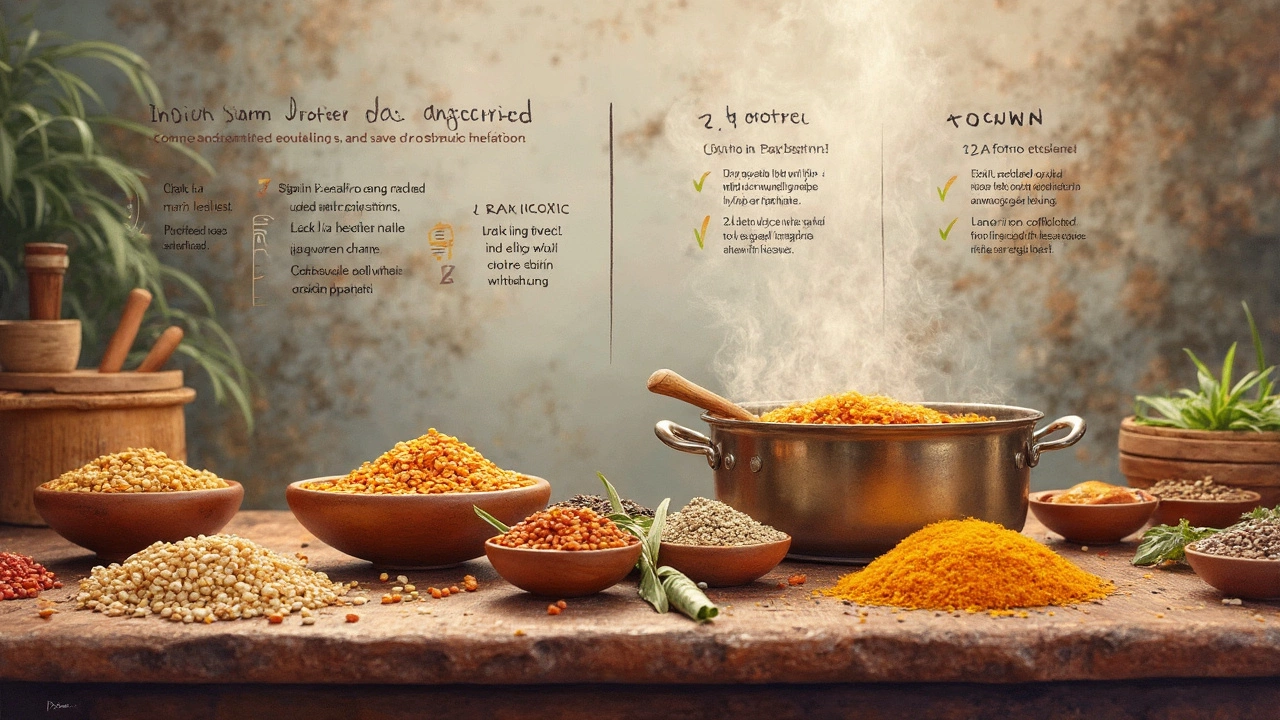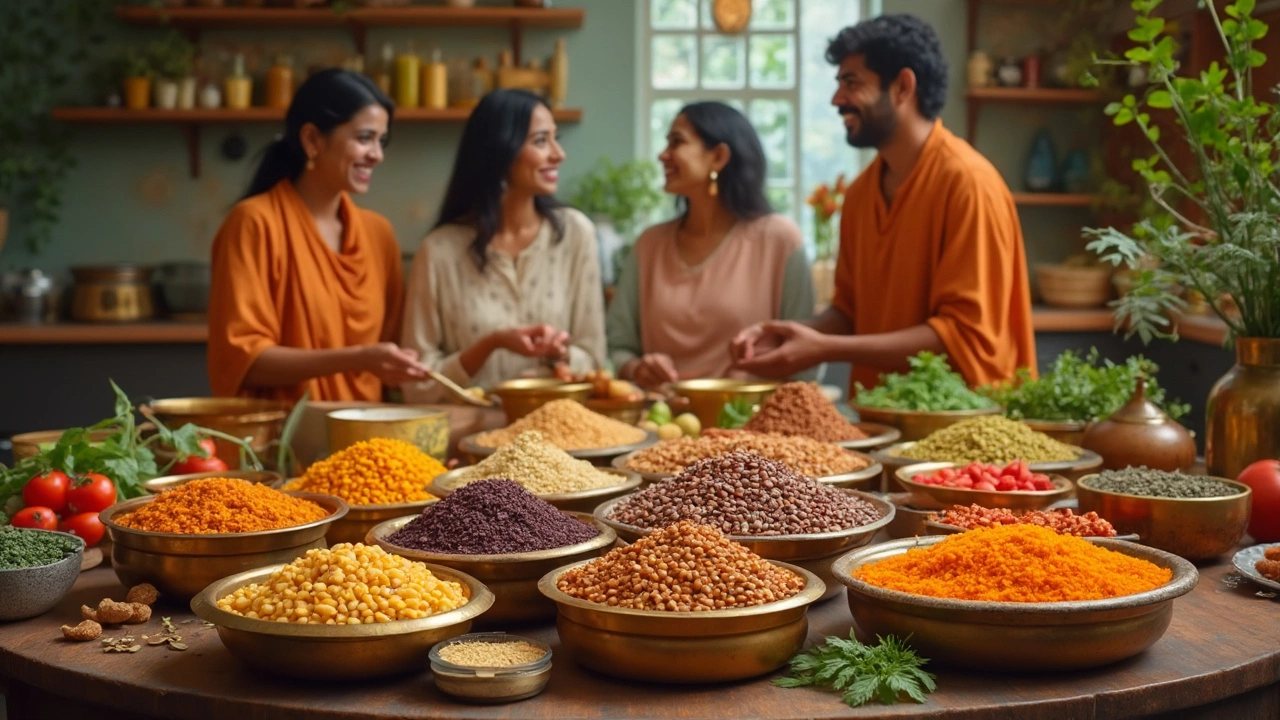Everyone’s got that one relative who swears dal has more protein than a chicken breast. But if you’re topping up your protein just by piling on dal, you’re missing a key detail. Dal is packed with nutrients, but there’s a reason dietitians don’t call it a true protein source the same way they talk about eggs or paneer.
Here’s the deal—dal is mainly made up of carbs. Sure, it’s got more protein than, let’s say, rice, but you’d have to eat a huge amount to reach your daily protein goal. And eating loads of dal means you’ll also get a lot of calories from carbs, which can throw off your meal balance if you’re not careful.
Ever heard people talk about “complete” proteins? That’s the crux of the dal confusion. Dal has protein, but it’s missing some amino acids your body needs. It’s a solid base, especially for vegetarians, but there’s more to the story if you actually want to get all the benefits of dietary protein. So, the next time someone waves off your interest in paneer or eggs by saying, “Eat more dal,” you’ll know what’s really up.
- The Protein Myth: What’s Actually in Dal?
- Dal vs Complete Proteins: What’s Missing?
- How to Make Dal a Stronger Protein Source
- Simple Dal Recipe Tips for Maximum Nutrition
The Protein Myth: What’s Actually in Dal?
Most people think they’re getting all their protein needs filled by scooping extra dal onto their plate. But here’s the honest truth: dal is not a protein powerhouse like many believe. If you look closely, you’ll see dal is actually loaded with carbs, and its protein content is decent, but not stellar.
Let’s check out some real numbers. Here’s what you get in 100 grams (about half a cup cooked) of common dals:
| Type of Dal | Protein (g) | Carbohydrate (g) | Fat (g) |
|---|---|---|---|
| Toor Dal | 7.2 | 29 | 1.7 |
| Masoor Dal | 9 | 27 | 1.1 |
| Moong Dal | 8.5 | 24 | 1.1 |
See those numbers? The carbs are always way higher than the protein. So if dal is your main protein source, you’re also taking in a good amount of carbs.
The dal hype mostly comes from the fact that it does have more protein than rice, roti, or most cooked veggies. But if you compare it to animal proteins or even paneer, dal is lagging behind. For example, 100 grams of chicken or paneer easily gives you around 20 grams of protein—double or even triple what you get from dal.
One more thing: dal is also a great source of fiber, B vitamins, and iron. It’s a super food in many ways, but relying on it just for protein might leave your body wanting more. So next time you’re making that big bowl of dal, remember you’re getting a balanced mix, not a pure protein hit.
Dal vs Complete Proteins: What’s Missing?
This might surprise you, but not all proteins are equal—especially when you look at where they come from. Dal has protein, but is it the kind your body really loves? Here’s the scoop: protein is made of building blocks called amino acids. There are nine essential amino acids your body can’t make, so you need all of them from your food.
Foods that have all nine in good quantities are called “complete proteins.” Dal, no matter which type you choose—moong, masoor, chana, or urad—doesn’t hit all nine marks. It falls short, mostly missing methionine, one of those must-have amino acids.
“While dals and pulses provide quality nutrition, they are not considered complete proteins as they are low in certain essential amino acids, specifically methionine. Combining them with grains like rice or wheat bridges this gap.” — Indian Dietetic Association, April 2024
Let’s get a bit numbers-oriented. Check out how dal stacks up against animal protein sources:
| Food | Protein (g per 100g) | Complete Protein? |
|---|---|---|
| Boiled Moong Dal | 7 | No |
| Boiled Eggs | 13 | Yes |
| Cooked Chicken | 27 | Yes |
| Cooked Rice | 2.7 | No |
See that? Dal beats rice for protein but loses to eggs and chicken, both in amount and quality. That’s why vegetarians hear so much about “protein combining” (think dal with rice or roti). This clever trick fills in what’s missing in dal—when you eat them together in one meal, your body gets the full set of amino acids.
- Dal is rich in lysine but low in methionine.
- Rice or wheat is low in lysine but high in methionine.
- Pairing them gives you something close to a complete protein meal.
That’s why a simple dal chawal isn’t just comfort food—it’s a nutrition hack passed down for generations, especially for anyone relying on plant-based protein sources.

How to Make Dal a Stronger Protein Source
If you want your dal to truly pull its weight in your diet, you’ve got to get a little clever in the kitchen. Eating plain dal isn’t bad, but if you want a better protein punch, mixing things up is the key. The main thing missing from dal is a couple of important amino acids, but you can fill in the gaps with the right food combos.
Number one trick? Pair dal with grains like rice, roti, or even quinoa. Grains have the amino acids dal lacks, so when eaten together, your body gets almost a complete protein. This isn’t some new idea—it’s actually the reason why classics like dal-rice or dal-chapati are such a staple at home. Here’s a quick table that shows how the combo works:
| Food | Missing Amino Acid | Balances with |
|---|---|---|
| Dal (lentils/pulses) | Methionine | Rice, wheat, other grains |
| Rice/Wheat | Lysine | Dal, beans, pulses |
Adding dairy is another win—throw in a little paneer or curd, and suddenly your dal meal gets much closer to having all the amino acids. Even topping your dal with a bit of Greek yogurt can do the trick.
Want to go a step further? Stir in extra protein-rich ingredients like boiled eggs (if you’re not vegan), tofu cubes, or sprinkle in some seeds like chia or hemp for an extra boost. Adults usually need about 0.8 grams of protein per kilogram of body weight, and bumping up dal with these additions can help you hit your goal a lot faster.
- Pair your dal with rice, roti, or quinoa for a more balanced meal.
- Add paneer, curd, or tofu for extra protein.
- Try topping dal with roasted seeds or nuts for crunch and nutrients.
Keep a basic lentil dish as your base, then level it up with these little tweaks. You’ll get way more out of every serving, and your meals will feel a lot more satisfying, too.
Simple Dal Recipe Tips for Maximum Nutrition
If you’re looking to boost the nutrition in your regular dal, it’s all about smart tweaks. You don’t need pricey superfoods or fancy ingredients. Start with what you have and make your usual dal sharper on the nutrition front.
One big trick is to pair dal with cereals like rice or whole wheat roti. Why? This combo fills in the missing amino acids dal lacks. Basically, putting dal and rice together turns your meal into a more complete protein, closer to what you’d get from meat or dairy.
Want to power up your dal even more? Toss in veggies. Spinach, carrots, or even bottle gourd blend right into the pot and ramp up the fiber, vitamins, and minerals. And if you want extra protein, stir in some paneer cubes or boiled eggs (if you eat them), especially for growing kids or anyone with bigger protein needs.
- Try mixed dals: Using two or three types of dal, like moong and masoor together, brings more variety to the amino acid profile.
- Add nuts and seeds: Toss in a spoonful of roasted peanuts, sunflower seeds, or chia after cooking. It's an easy way to get healthy fats and protein.
- Don’t overcook: Cooking dal until it’s just soft (not totally mushy) keeps more nutrients intact.
- Top with fresh coriander and lemon: Both add vitamin C, which helps your body absorb iron from dal better.
Here’s a peek at how much protein you actually get from common dals (per 100g, uncooked):
| Dal Type | Protein (g) |
|---|---|
| Moong Dal | 24 |
| Masoor Dal | 25 |
| Toor Dal | 22 |
| Chana Dal | 21 |
Just remember, 100g uncooked is a big serving, so after cooking and splitting portions, you usually get 6-10g per bowl. To hit daily goals, mix and match dal with other protein sources, especially if you’re vegetarian or vegan.
Quick tip: if you meal-prep dal for the week, make a different mix each time—like moong-spinach one day, masoor-carrot the next. Your tastebuds and your nutrition score will both thank you.
